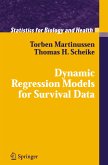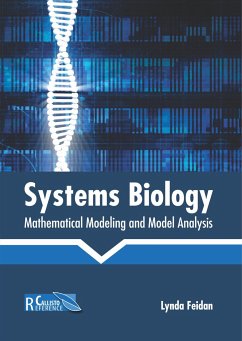Dynamic Systems Biology Modeling and Simuation consolidates and unifies classical and contemporary multiscale methodologies for mathematical modeling and computer simulation of dynamic biological systems - from molecular/cellular, organ-system, on up to population levels. The book pedagogy is developed as a well-annotated, systematic tutorial - with clearly spelled-out and unified nomenclature - derived from the author's own modeling efforts, publications and teaching over half a century. Ambiguities in some concepts and tools are clarified and others are rendered more accessible and practical. The latter include novel qualitative theory and methodologies for recognizing dynamical signatures in data using structural (multicompartmental and network) models and graph theory; and analyzing structural and measurement (data) models for quantification feasibility. The level is basic-to-intermediate, with much emphasis on biomodeling from real biodata, for use in real applications.
Hinweis: Dieser Artikel kann nur an eine deutsche Lieferadresse ausgeliefert werden.
Hinweis: Dieser Artikel kann nur an eine deutsche Lieferadresse ausgeliefert werden.
"This very satisfying book has multiple strengths. The text has marvelous clarity, as do the mathematical demonstrations. All are synoptic, while simultaneously explaining the underlying, fine details. The useful organization is enhanced by superb graphics. Although the author has many technical capabilities, with both range and depth, below I ll give just one illustrative example of the excellent result. Major themes of modern computation and modeling, as applied to biology, include issues of nonlinearities, chaotic dynamics, emergent properties, and instabilities. For example, consider the problems attendant on complex dynamic systems with multiple scales of time and space so typical of living systems. The scientific literature in this domain is rich and immense. When I looked into DiStefano s book for entries dealing with these topics, I found as early as Chapter One a heading: Multiscale Modeling . Elsewhere were other treatments of these aspects of complexity and modeling difficulties such as the famous problem of stiff ODEs , here brilliantly examined and explained, with remedies. The many authoritative tutorials by DiStefano amazed me for so effectively distilling the technical essences. They confirm that DiStefano is a great teacher and guide through various profound, classical difficulties. This book is a masterwork." --F. Eugene Yates
"This book provides a systematic review of the concepts of mathematical modeling in various fields. With its simple language, varied practical examples, quick references, appendixes, and clear basic concepts, it provides a thorough explanation of the subject. The well-organized chapters, along with the use of different notations and typescripts, make it a user-friendly book." Rating: 5 Stars--Doody.com, March 7, 2014
"DiStefano presents this interdisciplinary text merging mathematics, modeling, systems science, and biology. The first chapter introduces the philosophy and nomenclature of modeling and simulation. Chapter two covers mathematics including algebraic models, differential equations, linear and nonlinear modeling, and chapter three describes the use of Taylor series and algorithmic treatment of differential equations in computer simulation methods."--ProtoView.com, February 2014
I am just in awe of your ability to start with simple ideas and use them to explain sophisticated concepts and methodologies in modeling biochemical and cellular systems (Chapters 6 and 7). This is a great new contribution to the textbook offerings in systems biology. --Alex Hoffmann, Director of the San Diego Center for Systems Biology and the UCSD Graduate Program in Bioinformatics and Systems Biology
"I found Chapter 1 to be a marvel of heavy-lifting, done so smoothly there was no detectable sweat. Heavy-lifting because you laid out the big load of essential vocabulary and concepts a reader has to have to enter the world of biomodeling confidently. In that chapter you generously acknowledge some us who tried to accomplish this earlier but, compared to your Chapter 1, we were clumsy and boring. For me, now, Chapter 1 was a "page-turner" to be enjoyed straight through. You have the gift of a master athlete who does impossible performances and makes them seem easy.
Your Chapter 9 - on oscillations and stability - is a true jewel. I have a shelf full of books etc on nonlinear mechanics and system analyses and modeling, but nothing to match the clarity and deep understanding you offer the reader. You are a great explainer and teacher." --F. Eugene Yates, Emeritus Professor of Medicine, Chemical Engineering and Ralph and Marjorie Crump Professor of Biomedical Engineering, UCLA
"This book provides a systematic review of the concepts of mathematical modeling in various fields. With its simple language, varied practical examples, quick references, appendixes, and clear basic concepts, it provides a thorough explanation of the subject. The well-organized chapters, along with the use of different notations and typescripts, make it a user-friendly book." Rating: 5 Stars--Doody.com, March 7, 2014
"DiStefano presents this interdisciplinary text merging mathematics, modeling, systems science, and biology. The first chapter introduces the philosophy and nomenclature of modeling and simulation. Chapter two covers mathematics including algebraic models, differential equations, linear and nonlinear modeling, and chapter three describes the use of Taylor series and algorithmic treatment of differential equations in computer simulation methods."--ProtoView.com, February 2014
I am just in awe of your ability to start with simple ideas and use them to explain sophisticated concepts and methodologies in modeling biochemical and cellular systems (Chapters 6 and 7). This is a great new contribution to the textbook offerings in systems biology. --Alex Hoffmann, Director of the San Diego Center for Systems Biology and the UCSD Graduate Program in Bioinformatics and Systems Biology
"I found Chapter 1 to be a marvel of heavy-lifting, done so smoothly there was no detectable sweat. Heavy-lifting because you laid out the big load of essential vocabulary and concepts a reader has to have to enter the world of biomodeling confidently. In that chapter you generously acknowledge some us who tried to accomplish this earlier but, compared to your Chapter 1, we were clumsy and boring. For me, now, Chapter 1 was a "page-turner" to be enjoyed straight through. You have the gift of a master athlete who does impossible performances and makes them seem easy.
Your Chapter 9 - on oscillations and stability - is a true jewel. I have a shelf full of books etc on nonlinear mechanics and system analyses and modeling, but nothing to match the clarity and deep understanding you offer the reader. You are a great explainer and teacher." --F. Eugene Yates, Emeritus Professor of Medicine, Chemical Engineering and Ralph and Marjorie Crump Professor of Biomedical Engineering, UCLA








